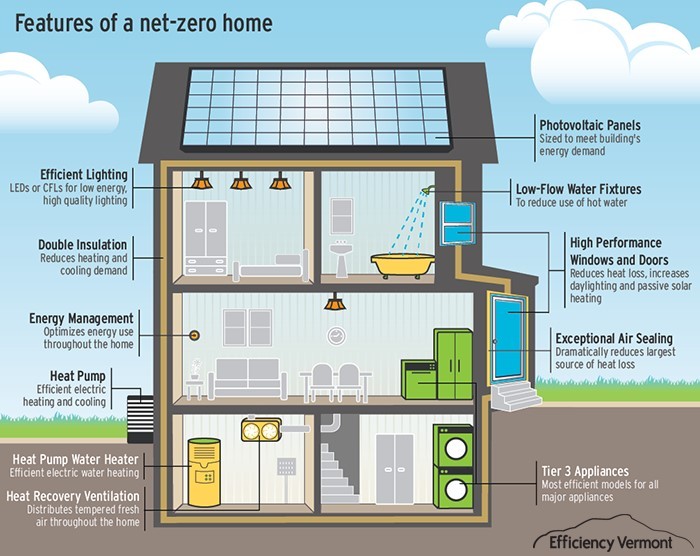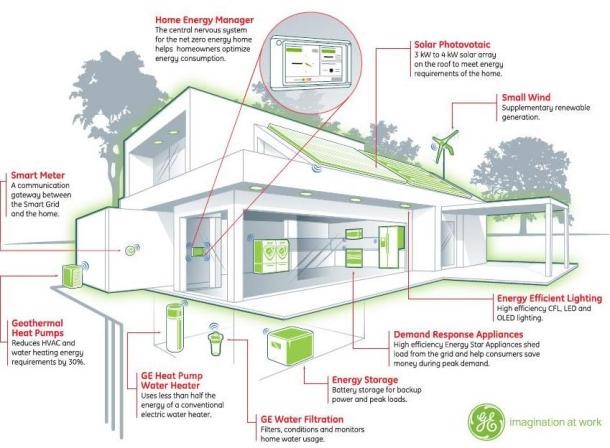Defining Net Zero Energy Housing
NZE buildings often combine exemplary building design to minimize energy requirements and renewable energy systems that meet these reduced energy needs.

Net Zero Energy (NZE) Housing creates roughly as much renewable energy as the amount of energy it consumes. Such houses would contribute less overall greenhouse gas to the atmosphere than standard houses.
Net Zero Site Energy refers to the energy consumed and generated at the site . This type of building produces as much energy as it uses when accounted for at the site. Generation examples include roof-mounted PV (Photovoltaic) or solar hot water collectors. Alternative site generation options include small-scale wind power and low-impact hydro.
Source Energy refers to primary energy needed to extract and deliver new energy to a site.
Many NZE buildings are connected to the electric grid, allowing electricity produced from traditional energy sources to be used.
Net-zero energy cost means that the building has an energy utility bill of 0 over the course of the year. In some cases, building owners or operators may take advantage of selling Renewable Energy credits from onsite renewable generation.
A Net Zero Source Energy Building produces as much energy as it uses as measured at the source.
Context
Human activity is causing a significant negative impact on the Earth’s geology. One of the biggest problems that our generation faces is how human beings can inhabit the earth in a manner that is more conducive to nature.
Currently, approximately 50% of nonrenewable resources that mankind consumes are through the construction industry, making it one of the least sustainable industries in the world. This highlights the importance of targeting building energy use as an effective method of decreasing energy consumption. Methods to decrease energy consumption include: incorporating energy-efficient strategies into the design process, construction and operation of new buildings, and retrofitting existing buildings to improve their efficiency. Our current reliance on fossil fuels can be reduced by increasing the use of renewable energy sources.
Net Zero Energy Housing becomes more feasible with advances in construction technologies, renewable energy systems, and academic research.

A Standard Definition
Another difficulty in attaining NZE is defining what this means. Consistent ZNE definitions may be helpful for those who research, fund, design, and evaluate ZNEs. It is quite difficult to define a ‘zero-energy building’ , and to obtain a universal understanding of what this phrase means.
By using ZNE design goals, this progresses building design from being simply low energy to pursuing a percent energy savings goal into the realm of a sustainable energy endpoint.
At the core of the ZNE building concept is the idea that buildings can meet all their energy requirements from low-cost, locally available, non-polluting, renewable sources.
Technologies
Some technologies that are available for ZNE buildings include PV, solar hot water, wind, hydroelectric, and biofuels. All these renewable sources are preferred over conventional energy sources such as coal and natural gas.
Rooftop PV and solar water heating are the most applicable supply-side technologies for the widespread application of ZNE buildings.
Reducing the site energy use through low-energy building technologies such as daylighting, high-efficiency HVAC equipment, natural ventilation, evaporative cooling are methods to meet NZE. On-site supply options include using renewable energy sources available at the site PV, solar hot water, low impact hydro, and wind located on the building.
Microturbines and fuel cells can be used to transform purchased fossil fuels into heat and electricity.
Strategies To Attain NZE
High-Performance homes attempting to achieve net-zero energy performance often use unconventional materials and construction practices.
The ideal site for a zero net energy house would be one with unobstructed sunlight, flat topography, and minimal weather exposure.
Simpler building masses will be easier and less expensive to build, easier to air seal and insulate.
Smaller-scale housing will save energy and pay for all the energy improvements in a zero energy home.
A clearly defined thermal boundary will improve efficiency. Using only one type of ceiling throughout the house can reduce the need to air seal and insulate.
Measures must be specified to avoid thermal bridging on plans.
The wall insulation must be specified as fully enclosed with rigid sheets of high-performance panels and walls must properly cover insulation.
Working Towards Net Zero
The design of NZE buildings can start by assessing local resources and evaluating core energy consumption needs. Optimization of a building’s energy efficiency typically considers; lighting, the walls and roof, glazing, heating, ventilation, air conditioning, and renewables. Energy-efficient lighting replaces incandescent lamps with fluorescent.
The walls, roof, and glazing should be designed to consider the need for thermal insulation; making use of materials with a high thermal mass to help retain heat in the building. Human behaviour plays an important part in reducing energy consumption. Typically NZE buildings incorporate sensors to automatically adjust heating/ cooling systems.
Conclusion
We must collectively connect energy efficiency knowledge and technologies which support energy efficiency innovation to promote the availability of this information.
Action must be made to research & implement new and better information. The benefits of energy efficiency are significant, including boosting growth and creating jobs, saving households money on fuel bills & creating a more sustainable and secure energy system.
A greener future through good design should be sought, with buildings becoming NZE and if possible, energy generation centers.
Sources
Net Zero Energy Buildings | WBDG Whole Building Design Guide
http://www.enob.info/en/net-zero-energy-buildings/nullenergie-projekte-weltweit/
http://newbuildings.org/hubs/zero-net-energy/
http://newbuildings.org/hubs/zero-net-energy/















